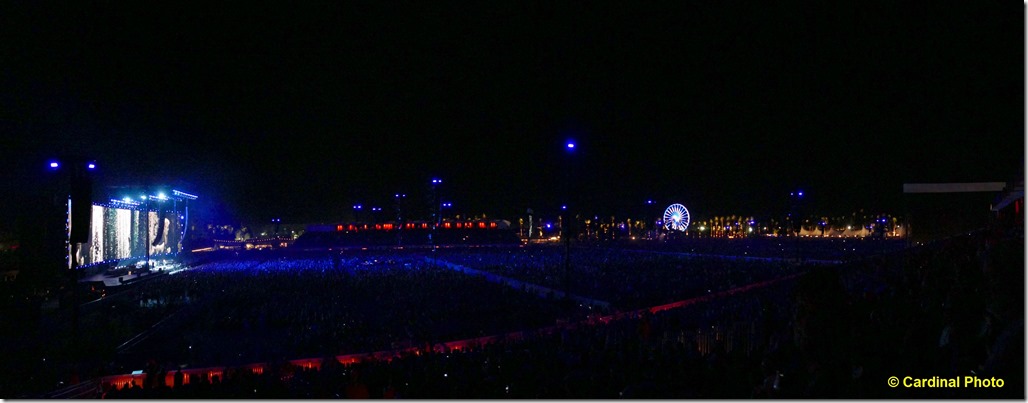- Photo Safaris
- Alaska Bears & Puffins World's best Alaskan Coastal Brown Bear photo experience. Small group size, idyllic location, deluxe lodging, and Puffins!
- Participant Guestbook & Testimonials Candid Feedback from our participants over the years from our photo safaris, tours and workshops. We don't think there is any better way to evaluate a possible trip or workshop than to find out what others thought.
- Custom Photo Tours, Safaris and Personal Instruction Over the years we've found that many of our clients & friends want to participate in one of our trips but the dates we've scheduled just don't work for them or they'd like a customized trip for their family or friends.
- Myanmar (Burma) Photo Tour Myanmar (Burma) Photo Tour December 2017 -- with Angkor Wat option
- Reviews Go hands-on
- Camera Reviews Hands-on with our favorite cameras
- Lens reviews Lenses tested
- Photo Accessories Reviews Reviews of useful Photo and Camera Accessories of interest to our readers
- Useful Tools & Gadgets Handy tools and gadgets we've found useful or essential in our work and want to share with you.
- What's In My Camera Bag The gear David Cardinal shoots with in the field and recommends, including bags and tools, and why
- Articles About photography
- Getting Started Some photography basics
- Travel photography lesson 1: Learning your camera Top skills you should learn before heading off on a trip
- Choosing a Colorspace Picking the right colorspace is essential for a proper workflow. We walk you through your options.
- Understanding Dynamic Range Understanding Dynamic Range
- Landscape Photography Tips from Yosemite Landscape Photography, It's All About Contrast
- Introduction to Shooting Raw Introduction to Raw Files and Raw Conversion by Dave Ryan
- Using Curves by Mike Russell Using Curves
- Copyright Registration Made Easy Copyright Registration Made Easy
- Guide to Image Resizing A Photographers' Guide to Image Resizing
- CCD Cleaning by Moose Peterson CCD Cleaning by Moose Peterson
- Profiling Your Printer Profiling Your Printer
- White Balance by Moose Peterson White Balance -- Are You RGB Savvy by Moose Peterson
- Photo Tips and Techniques Quick tips and pro tricks and techniques to rapidly improve your photography
- News Photo industry and related news and reviews from around the Internet, including from dpreview and CNET
- Getting Started Some photography basics
- Resources On the web
- My Camera Bag--What I Shoot With and Why The photo gear, travel equipment, clothing, bags and accessories that I shoot with and use and why.
- Datacolor Experts Blog Color gurus, including our own David Cardinal
- Amazon Affiliate Purchases made through this link help support our site and cost you absolutely nothing. Give it a try!
- Forums User to user
- Think Tank Photo Bags Intelligently designed photo bags that I love & rely on!
- Rent Lenses & Cameras Borrowlenses does a great job of providing timely services at a great price.
- Travel Insurance With the high cost of trips and possibility of medical issues abroad trip insurance is a must for peace of mind for overseas trips in particular.
- Moose Peterson's Site There isn't much that Moose doesn't know about nature and wildlife photography. You can't learn from anyone better.
- Journeys Unforgettable Africa Journeys Unforgettable -- Awesome African safari organizers. Let them know we sent you!
- Agoda International discounted hotel booking through Agoda
- Cardinal Photo Products on Zazzle A fun selection of great gift products made from a few of our favorite images.
- David Tobie's Gallery Innovative & creative art from the guy who knows more about color than nearly anyone else
- Galleries Our favorite images
Lumix ZS100: A Goldilocks camera for image lovers who need more zoom from their point and shoot
Lumix ZS100: A Goldilocks camera for image lovers who need more zoom from their point and shoot
Submitted by David Cardinal on Tue, 10/18/2016 - 13:23
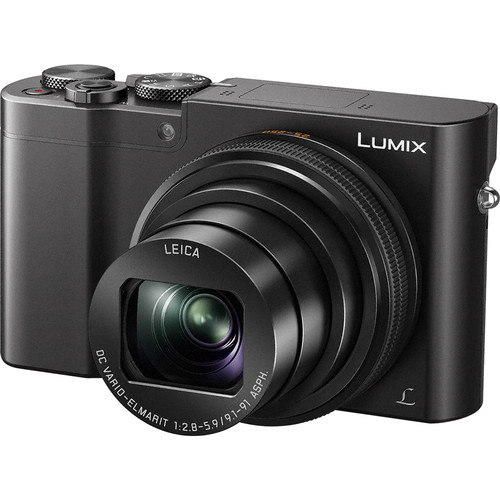 A common theme in compact cameras is the tradeoff between zoom range and image quality. The very top rated Sony RX100 V (our article) has the best image quality, but a small zoom range of 24-70mm. The Canon G5 X (full review) stretches that to 24-100mm, but that’s not much of a gain. On the other extreme, the Sony RX10 III (full review) provides both an amazing zoom and great image quality, but is much larger and more expensive. Enter the Lumix ZS100. It is larger than the RX100 or Canon G series, but not by a huge amount. In exchange it offers a larger, 25-250mm, zoom range but doesn’t trade off much in image quality.
A common theme in compact cameras is the tradeoff between zoom range and image quality. The very top rated Sony RX100 V (our article) has the best image quality, but a small zoom range of 24-70mm. The Canon G5 X (full review) stretches that to 24-100mm, but that’s not much of a gain. On the other extreme, the Sony RX10 III (full review) provides both an amazing zoom and great image quality, but is much larger and more expensive. Enter the Lumix ZS100. It is larger than the RX100 or Canon G series, but not by a huge amount. In exchange it offers a larger, 25-250mm, zoom range but doesn’t trade off much in image quality.
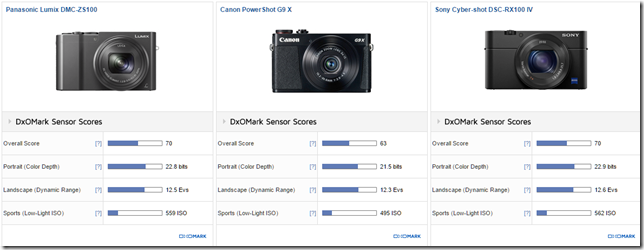
The ZS100 holds its own with other compacts in image quality.
Note that there isn’t a comparison score for the G3X, so I included my favorite inexpensive model,
the Canon G9 X, which is always in my pocket unless I’m reviewing something else
The ZS100 has a high-quality, integrated, EVF – which I much prefer to the “pop-up” style that requires fiddling to use. Coupled with both a touchscreen and a familiar-feeling set of classic “point-and-shoot” controls, the camera is about as easy to use as a compact camera can be. Front & top controls are also a welcome feature for those used to high-end cameras. It has customizable function buttons for even more flexibility. It’s small pop-up flash is certainly okay in a pinch, and about as good as you can expect from a small camera. Purists won’t like that there is no hot shoe, but that is pretty typical for all but the largest of the compact cameras. The camera’s AF system is snappy, and keeps up with bursts up to 6 fps (10 fps without AF). However, it is only based on Contrast detection, while some of the more expensive models, like the Sony RX100 V have added the faster Phase detection technology. It includes face and eye tracking to keep focus once acquired.
The Leica-designed 10-element lens is a fairly-bright f/2.8 at the wide end, stopping down to a respectable f/5.9 at full zoom. A 5-axis “hybrid” optical image stabilization system rounds out the camera’s optical system. There’s a kind of cool “Level Shot” capability, that will try to re-orient a video to keep horizontal lines level as you tilt the camera. The Panorama feature also works well (one of the few features missing from my tiny Canon G9 X).
In-camera panorama of the Desert Trip festival taken with the Lumix ZS100
I shot at –1.5 e.v. to avoid the highlights blowing out, and then used a simple “Auto Curves” in Photoshop to try to save some of the shadows
Generally good image quality, especially at the wide end
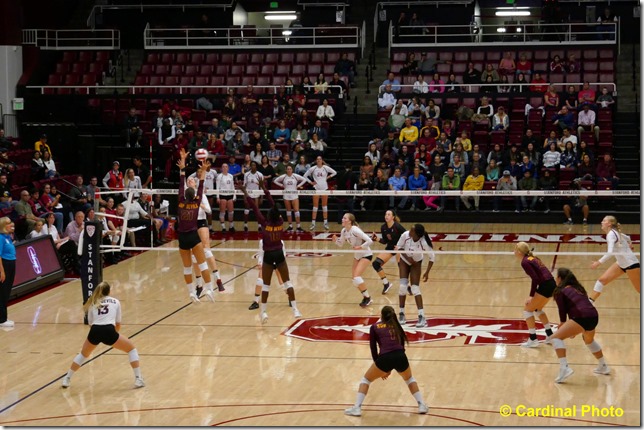
If you keep the ZS100’s lens fairly wide (about 100mm here) you get okay apertures (f/5.1 here)
and can get quick shutter speeds (1/250s here) at plausible ISOs (3200 here)
Stanford Women’s Volleyball, indoors at Maples.
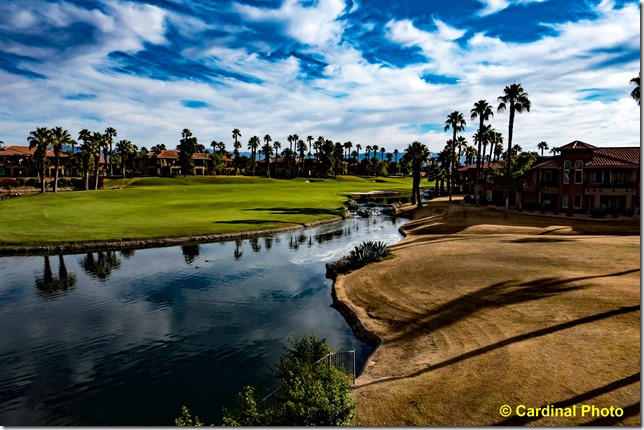
Even though I completely messed up by leaving the –1-2/3 e.v. dialed in
this scenic from our hotel room recovered nicely with a little tweaking
That speaks well of the camera’s native ability to capture shadow detail.
Do you need more zoom? You know who you are!
I’m a big believer that the best camera is the one you have with you, so even though I have a shelf full of various “large” cameras, I always have my Canon G9 X compact in my pocket, just in case. Even if I have a DSLR out and set up, often I want to take a quick shot of something else and the quickest way is to grab for it. For its size and cost, it’s great and shoots RAW, so its awesome. But sometimes, you need more reach. If you find yourself doing a lot of cropping of your images, you’re a candidate for a longer zoom range. Especially with small-sensor cameras, heavy cropping is going to seriously impact image quality. In my case, I was headed down to the “once in a lifetime” Desert Trip (aka Oldchella) concert. Without a media credential, I’d be limited to a “non-Pro” camera. Not sure what that meant, but knowing I’d need more than the 70mm zoom of my little Canon, I did some research and decided the Lumix ZS100 would be perfect for the job.
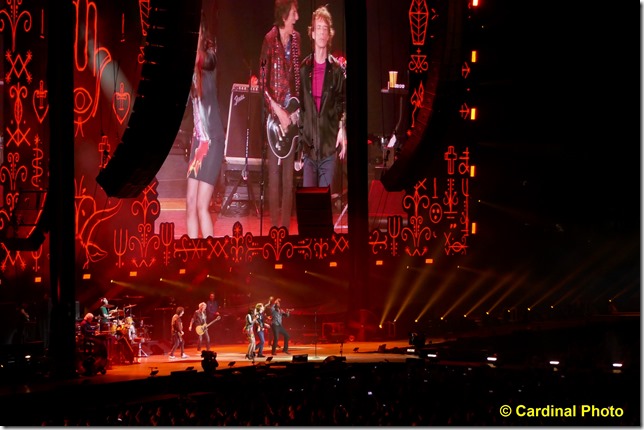
The Rolling Stones, Desert Trip @ 250mm
1/100s @ f/5.7, ISO 1600
-1 2/3 e.v. per usual for night concerts
All in all, I was very pleased. I shot in RAW+JPEG for stills, and in 4K resolution for videos. The concerts were mostly at night so, even with stage lights, I had to push the ISO to 1600 or 3200. That’s far from ideal for a compact camera, but the images came out reasonably well. As you’d expect, the lens is variable maximum aperture, so as I zoomed in, I needed to increase the ISO to keep my shutter speed. As a result, my 250mm shots were far from ideal, but the fact that I could take them at all was sort of amazing. I actually also really liked the in-camera JPEGs (like the above image of The Rolling Stones. I felt that the camera’s noise reduction was actually better than I was able to do with some simple fiddling in Adobe’s Raw converters. Unfortunately, my favorite noise defeater, DxO’s OpticsPro with PRIME, doesn’t have support for the ZS100, so I couldn’t compare it.
Great Video, but don’t count on great audio
The 4K video I shot came out really well – especially after I ran it through YouTube’s image stabilization (which, if you haven’t tried it, is quite impressive). The audio, in contrast, even though stereo, came out a little tinny. Of course, expecting a pocket camera to mimic a multi-million dollar sound system is a little silly, but the Sony RX10 III certainly had much better audio. You can see some of the video clips I recorded online as a Desert Trip playlist:
The Bottom Line: Should you buy a Lumix ZS100?
For a change, this one is pretty straightforward. If you need a 10x zoom in a compact camera, and don’t want to sacrifice the image quality you get with a 1-inch format sensor, the Lumix ZS100 is well worth its $700. Just about the only downside is that it is a little bulkier than some of its competitors that have a smaller zoom range. In a perfect world, I might pair this with my Canon G9 X, carrying the smaller Canon most days, and switching to the Lumix when I’m planning on photographing an event.
Some more sample images from Desert Trip:
Desert Trip Night 1: Bob Dylan and The Rolling Stones
Desert Trip Night 2: Neil Young and Paul McCartney
Desert Trip Night 3: The Who and Roger Waters
Full specs:
Pixels
Actual: 20.9 Megapixel
Effective: 20.1 Megapixel
Sensor
1" MOS
File Formats
Still Images: JPEG, RAW
Movies: AVCHD Ver. 2.0, MP4
Audio: AAC, Dolby Digital 2ch
Max Resolution
20 MP: 5472 x 3648
Aspect Ratio
1:1, 3:2, 4:3, 16:9
Image Stabilization
Optical & Mechanical, 5-Way
Lens
Leica DC Vario-Elmarit, 12 elements in 10 groups
5 Aspherical
EFL: 9.1-91mm (35 mm equivalent: 25-250mm)
Aperture: f/2.8 (W) - 5.9 (T) to f/8
Zoom
Optical: 10x
Extra Optical Zoom (EZ): 14x
Extra Optical Zoom (EZ): 20x
Intelligent Zoom: 20x
Digital: 4x
Focus Range
Wide: 1.64' (50 cm) - Infinity
Telephoto: 2.30' (70 cm) - Infinity
Wide Macro: 1.97" (5 cm) - Infinity
ISO Sensitivity
Auto, 125-12800 (Extended Mode: 80-25600)
Shutter
Type: Mechanical
Speed: 60 - 1/2000 second
Type: Electronic
Speed: 1 - 1/16000 second
120 - 0 second in Time Mode
Exposure Metering
Center-weighted, Multi, Spot
Exposure Modes
Modes: Aperture Priority, Manual, Program, Shutter Priority
Compensation: -5 EV to +5 EV (in 1/3 EV steps)
White Balance Modes
Auto, Cloudy, Color Temperature, Daylight, Flash, Incandescent, Shade, White Set 1, White Set 2, White Set 3, White Set 4
Continuous Shooting
Up to 50 fps at 20.1 MP
Up to 10 fps at 20.1 MP
Up to 6 fps at 20.1 MP
Up to 2 fps at 20.1 MP
Up to 30 fps at 8 MP
Self Timer
10 Sec, 2 Sec
Flash Modes
Auto
Auto/Red-eye Reduction
Forced On
Forced On/Red-eye Reduction
Off
Slow Sync
Slow Sync/Red-eye Reduction
Built-in Flash
Yes
Maximum Effective Flash Range
Wide: 1.97 - 26.25' (0.6 - 8 m)
Telephoto: 2.30 - 12.47' (0.7 - 3.8 m)
Memory Card Type
SD
SDHC
SDXC
Video Recording
Yes, NTSC
Resolution
3840 x 2160p: 30 fps, 24 fps
1920 x 1080p: 60 fps, 30 fps, 24 fps
1920 x 1080i: 60 fps
1280 x 720p: 30 fps
640 x 480p: 30 fps
Video Clip Length
Up to 29 Min 59 Sec
Audio Recording
Built-in Mic: With Video, Stereo
Viewfinder Type
Electronic
Viewfinder Coverage
100%
Screen
3.0" LCD Rear Touch Screen (1,040,000 pixels)
Screen Coverage
100%
Connectivity/System Requirements
Connectivity
HDMI D (Micro), Micro-USB, USB 2.0
Wi-Fi
Yes, 802.11b/g/n built-in
Battery
1x Rechargeable Lithium-Ion Battery Pack, 7.2 VDC, 1025 mAh
Dimensions (WxHxD)
4.4 x 2.5 x 1.7" / 110.5 x 64.5 x 44.3 mm
Weight
11.01 oz / 312 g with battery and memory card
Package Weight
1.15 lb
Box Dimensions (LxWxH)
5.4 x 5.0 x 2.6"
- Log in to post comments

